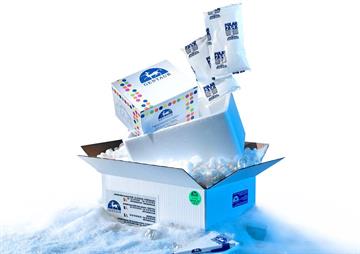Anti-Human MIA-2 Antibody

Anti-Human MIA-2 Antibody
518.55 EUR
In Stock
quantity
Produktdetaljer
Katalognummer: 209 - 102-P240
Produktkategori: Företag och industri > Vetenskap och laboratorium
ReliaTechGentaur
Storlek: 100 µg
Related Products
102-P239
Anti-Human MIA Antibody
MIA is the first discovered member of a family of secreted cytokines termed the MIA/OTOR family. The four known members of this family; MIA, MIA2, OTOR and TANGO each contain a Src homology-3 (SH3)-like domain. MIA is an autocrine growth regulatory protein secreted from chondrocytes and malignant melanoma cells that promotes melanoma metastasis by binding competitively to fibronectin and laminin in a manner that results in melanoma cell detachment from the extracellular matrix in vivo. Elevated levels of MIA may represent a clinically useful marker for diagnosis of melanoma metastasis as well as a potential marker for rheumatoid arthritis. Recombinant human MIA is a 12.2 kDa globular protein containing 108 amino acid residues including two intramolecular disulfide bonds. .
518.55 €
102-P240
Anti-Human MIA-2 Antibody
MIA2 is a secreted cytokine and a member of the MIA/OTOR family. Members of this family which also includes MIA, OTOR, and TANGO share a Src homology-3 (SH3)-like domain. MIA2 is predominantly expressed in hepatocytes. Elevated levels of MIA2 may represent a clinically useful marker for diagnosis of hepatic disease activity and severity. Recombinant human MIA-2 is a 101 amino acid, 11.5 kDa protein comprising the MIA homologous N-terminal region of the full length MIA-2 protein.
518.55 €
102-PA26
Anti-Human CCM-2 Antibody
Cerebral cavernous malformations (CCMs) are sporadically acquired or inherited vascular lesions of the central nervous system consisting of clusters of dilated thin-walled blood vessels that predispose individuals to seizures and stroke. Familial CCM is caused by mutations in KRIT1 (CCM1) or in malcavernin (CCM2). The roles of the CCM proteins in the pathogenesis of the disorder remain largely unknown. It was shown that the CCM1 gene product, KRIT1, interacts with the CCM2 gene product, malcavernin. Analogous to the established interactions of CCM1 and beta1 integrin with ICAP1, the CCM1/CCM2 association is dependent upon the phosphotyrosine binding (PTB) domain of CCM2. A familial CCM2 missense mutation abrogates the CCM1/CCM2 interaction, suggesting that loss of this interaction may be critical in CCM pathogenesis. CCM2 and ICAP1 bound to CCM1 via their respective PTB domains differentially influence the subcellular localization of CCM1. The data indicate that the genetic heterogeneity observed in familial CCM may reflect mutation of different molecular members of a coordinated signaling complex.
457.12 €
102-PA26S
Anti-Human CCM-2 Antibody
Cerebral cavernous malformations (CCMs) are sporadically acquired or inherited vascular lesions of the central nervous system consisting of clusters of dilated thin-walled blood vessels that predispose individuals to seizures and stroke. Familial CCM is caused by mutations in KRIT1 (CCM1) or in malcavernin (CCM2). The roles of the CCM proteins in the pathogenesis of the disorder remain largely unknown. It was shown that the CCM1 gene product, KRIT1, interacts with the CCM2 gene product, malcavernin. Analogous to the established interactions of CCM1 and beta1 integrin with ICAP1, the CCM1/CCM2 association is dependent upon the phosphotyrosine binding (PTB) domain of CCM2. A familial CCM2 missense mutation abrogates the CCM1/CCM2 interaction, suggesting that loss of this interaction may be critical in CCM pathogenesis. CCM2 and ICAP1 bound to CCM1 via their respective PTB domains differentially influence the subcellular localization of CCM1. The data indicate that the genetic heterogeneity observed in familial CCM may reflect mutation of different molecular members of a coordinated signaling complex.
339 €
102-PA34
Anti-Human Dkk-2 Antibody
The dickkopf (DKK)-related protein family is comprised of four central members, DKK-1 - 4, along with the distantly-related DKK family member DKK-11 (Soggy), which is thought to be a descendent of an ancestral DKK-3 precursor due to its unique sequence homology to DKK-3 and no other DKK family member. DKK family members, with the exception of the divergent Soggy, share two conserved cysteine-rich domains and show very little sequence similarity outside of these domains. Playing an important regulatory role in vertebrate development through localized inhibition of Wnt-regulated processes, including anterior-posterior axial patterning, limb development, somitogenesis, and eye formation, DKKs have also been implicated post-developmentally in bone formation, bone disease, cancer, and neurodegenerative diseases. DKK proteins typically play an important regulatory role in the Wnt/β-catenin signaling pathway by forming inhibitory complexes with LDL receptor-related proteins 5 and 6 (LRP5 and LRP6), which are essential components of the Wnt/β-catenin signaling system. LRP5 and LRP6 are single-pass transmembrane proteins that appear to act as co-receptors for Wnt ligands involved in the Wnt/β-catenin signaling cascade. DKK-2 has been shown to both inhibit and enhance canonical Wnt signaling; enhancing Wnt signaling through direct high-affinity binding of DKK-2 to LRP6 during LRP6 overexpression, while inhibiting Wnt signaling and promoting LRP6 internalization through the formation of a ternary complex between DKK-2, LRP6, and Kremen-2. Recombinant Human DKK-2 fused to a C terminal His-tag derived from E. coli has a molecular weight of 26.0 kDa and contains 234 amino acid residues.
457.12 €
Håll dig uppdaterad! Visa tidigare publikationer

By: Author , 2 Comment
Anaplasmos hos hundar och katter – allt du behöver veta
23 August 2025

By: Author , 2 Comment
Solbränna – hur leker man säkert i solen?
16 August 2025

By: Author , 2 Comment
Biologiska läkemedel – Modernitet inom farmaci
1 August 2025

By: Author , 2 Comment
Icke-steroida antiinflammatoriska läkemedel – viktig information om populära läkemedel
22 July 2025








